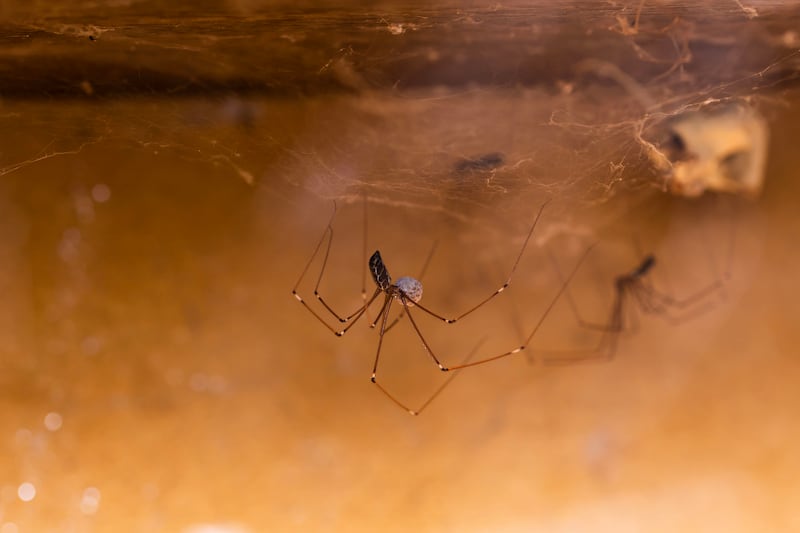 A daddy longlegs carrying its eggs in its jaw with a group of spiders in the background. (iStock / Getty Images)
A daddy longlegs carrying its eggs in its jaw with a group of spiders in the background. (iStock / Getty Images)
This is the time of year when people start asking questions about daddy longlegs, aka “harvestmen.” These familiar creatures can be found in moist areas, indoors and out, often in groups (which helps prevent them from drying out).
For some reason they scare the bejesus out of many folks, who must not understand that while harvestmen are arachnids, they are not spiders. They have only a single body segment while spiders have two. Both have eight legs, but harvestmen usually have longer ones.
Daddy longlegs are distinct from spiders in several other ways, including lacking silk glands and having two eyes instead of eight. They defend themselves not by biting but by emitting an unpleasant odor from leg glands.
These are really harmless critters. Their mouthparts cannot pierce human skin, so those who think they have been bitten by one are mistaken and should blame a spider instead. They forage for fungi, eat dead plants and animals and an occasional insect or bug. Females are bigger than the males, with legs that can extend nearly 2 inches.
How do these and other Alaska arachnids survive cold winters? They are not impacted by cold at all but go into what is known as diapause, or suspended animation, during winter.
Spiders? Yup, we have ‘em. The largest are known as dolomedes. These are semi-aquatic and are the ones you see walking on water. Their legs have specialized hairs that can read the vibrations in the water to locate small fish and insects. A spider taking out and eating fish? I thought that was only bears and humans!
Gardeners often encounter a black and yellow spider. Coming across one can be scary. Females are about an inch long. Their circular webs are big — about 2 feet in diameter. They bite, and while this will hurt and perhaps swell a bit, they are not considered dangerous.
There is another black and yellow spider you will find in your gardens, the yellow garden spider, Argiope aurantia. It has stripes on its legs and black and yellow markings on abdomens.
My favorite is the wolf spider, lycosidae, often seen inside during the winter. I like them because they take out mites – not that I have anything against mites. In summer, however, you will find them outdoors in wood and brush piles or in rotting logs. They are considered fantastic hunters due in part to their speed.
Then there is the flower crab spider or Thomisidae misumena. These can change colors between white and yellows. It can take a few days as they are not chameleons. Still, that is impressive.
There are a dozen or so spiders in these parts of the woods. I cannot identify them all here, but you have the tool to do identification yourself if you own a cellphone (and who doesn’t?). Take pictures and then use the ID function phones have nowadays thanks to AI. You can even use your phone’s search function to delve deeper.
Jeff’s Alaska Garden Calendar
Alaska Botanical Garden: Beer in The Garden. Thursday, Sept. 4, from 6-9 p.m. Taste a variety of craft beers and ciders from local breweries and tasty bites for purchase from vendors. This event also features live music, lawn games and fire pits.
Harvest: Carrots, snap and regular peas, kohlrabi. Carefully remove broccoli florets so new ones will grow in their place.
Gardens: Take pictures to study this winter.


Comments are closed.